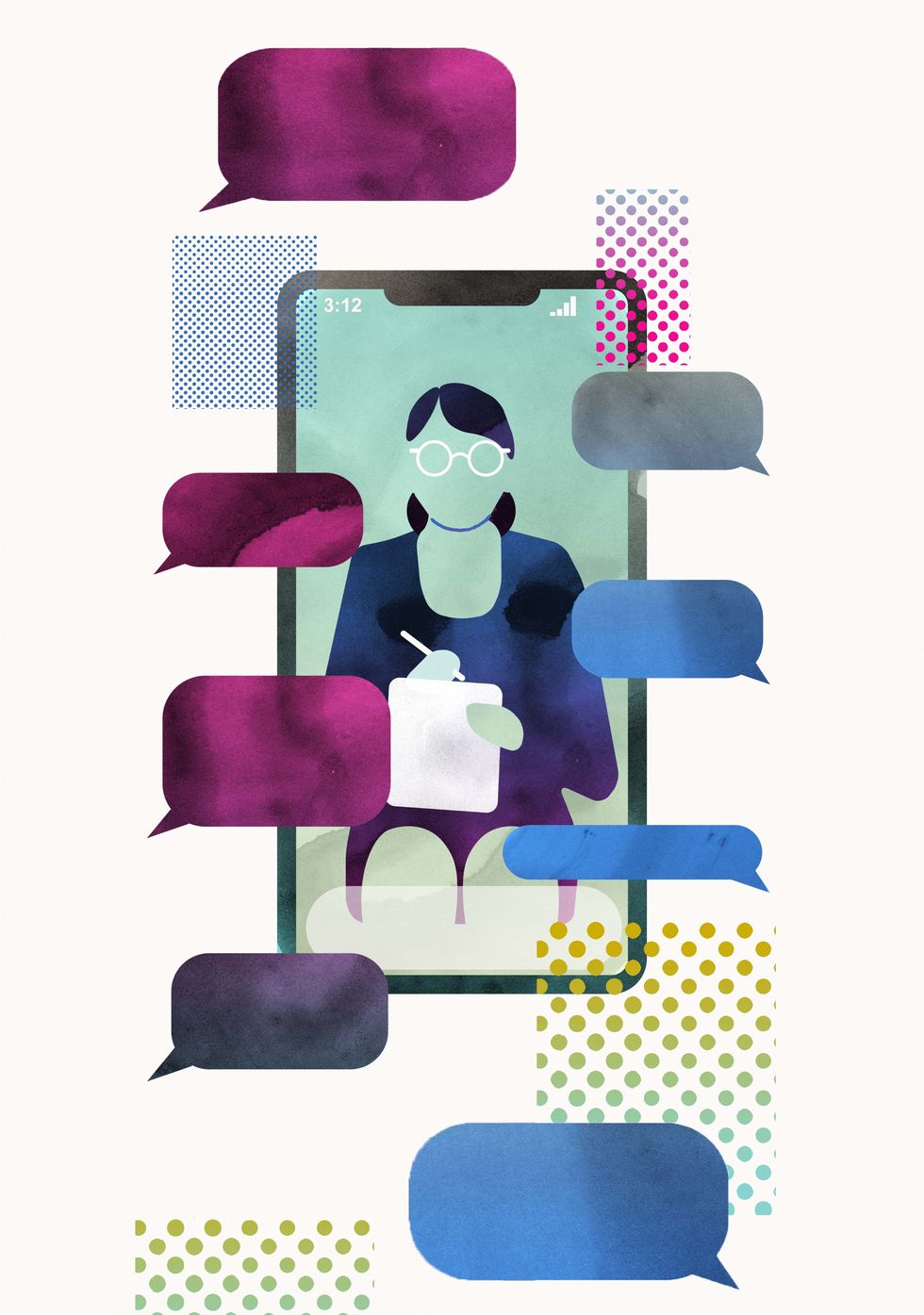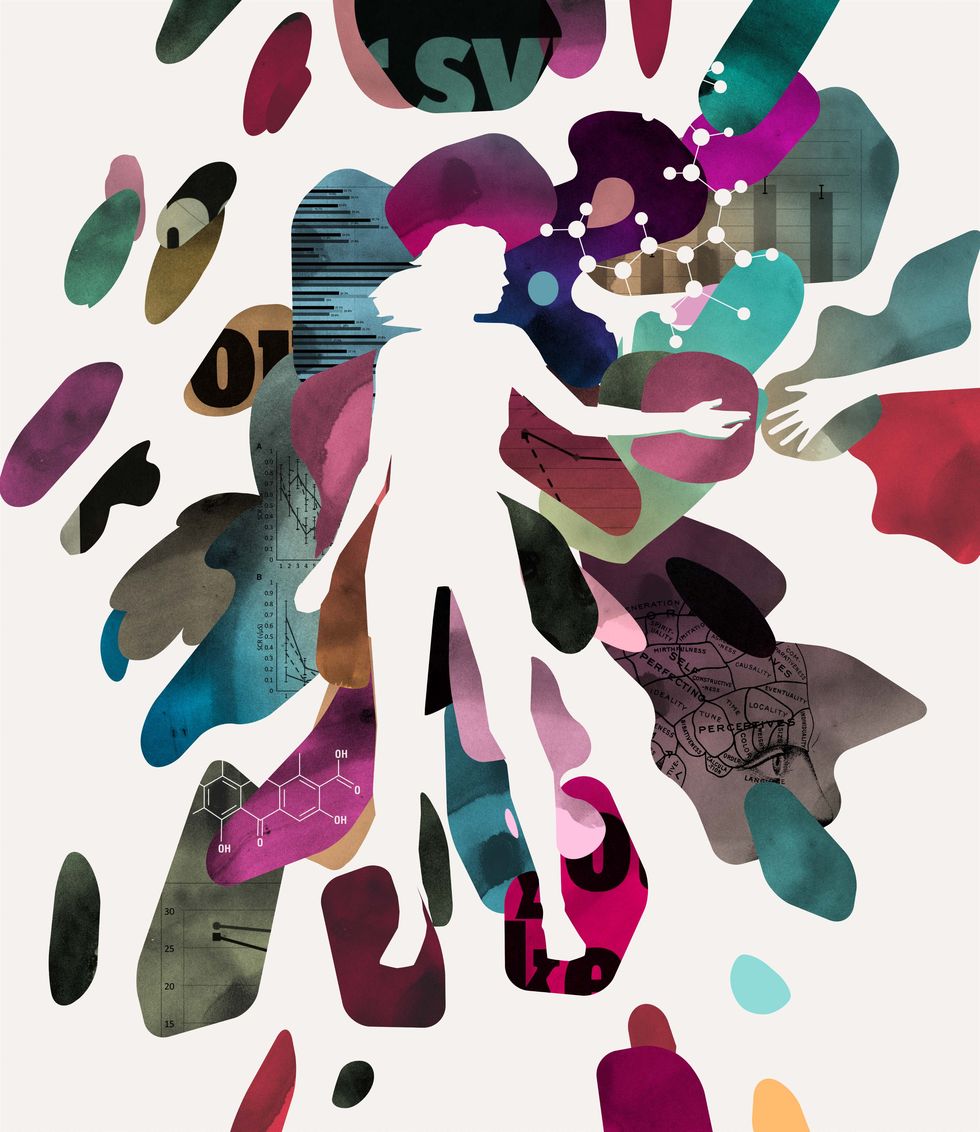This story is a member-exclusive for Oprah Daily Insiders.
Laura, a self-proclaimed feelings nerd, started seeing a therapist proactively before the birth of her daughter as a precaution against postpartum depression. Unfortunately, after only a few sessions, the therapist abruptly left the practice. Before Laura (last name withheld for privacy) could find someone new, her father fell gravely ill with Covid-19.
As an only child, Laura had to manage coordinating his care, and his medical decisions fell to her to handle, all while seven months pregnant and working. And, as is protocol with Covid patients, she couldn’t even be at her father’s bedside to comfort him as he passed away. “I wanted to lie on the couch, cry, and feel all the feelings,” says the 29-year-old. But between planning the memorial, managing his affairs, and taking care of a newborn, “grieving for my dad became something that had to happen in small pockets—like in the five minutes I had to shower.”
Around this time she stumbled upon Woebot, a chatbot therapy app. Though Laura had been skeptical when she first heard of AI therapy, now, amid a crisis, she was willing to give it a try.
She responded to a few prompts, and the app recognized she was grieving. It then asked her to describe her dad and her feelings about his death. “I realized that no one had asked me those questions and how badly I had needed to answer them,” says Laura. “I was able to put into writing how wonderful my dad was and how much I miss him. It felt like a weight was lifted.”
Woebot is but one example of how technology is changing the face of mental healthcare. Psychedelic drug treatments are coming to the fore, and interactive mind-body therapies, such as EMDR (eye movement desensitization and reprocessing) and somatic experiencing (SE), continue to be used. Therapy no longer just means lying on a couch talking about your childhood, and the hope is the field’s evolutions will make mental health help available to more people, in more areas.
TECHNOLOGY TO THE RESCUE?
It shouldn’t come as a surprise: People are stressed out right now. Here
in the U.S., before the pandemic, an estimated 11 percent of adults reported symptoms of anxiety and depression. As of June 2021, that number had climbed to 30 percent, according to data from the National Center for Health Statistics and the Census Bureau. But it’s not just Covid worrying us. “This past year has been very stressful for many in terms of a reckoning with racial justice issues and the political turmoil,” says Lynn Bufka, PhD, the American Psychological Association’s (APA) senior director of practice transformation and quality. Layer on top of that the fact that over 100 million Americans live in rural areas, which due to lack of funding or infrastructure have a shortage of mental health professionals (less than 1 per 30,000 residents), and you have the perfect petri dish for growing a mental health crisis.
Technology provides some hope. “Teletherapy has been positioned as a democratizing form of care,” says Hannah Zeavin, PhD, author of The Distance Cure: A History of Teletherapy. “It has long promised that it will open up the barriers to seeking mental healthcare in this country.”
That theory was tested during lockdown, when receiving therapy remotely became the default. The good news is that research suggests that sessions over the phone or via video can be just as effective as psychotherapy done when people are in the same room, says Bufka.
The less good news: Only 5 percent of those surveyed for a Time magazine Harris Poll said they’d gotten mental healthcare for the first time during Covid, meaning the expansion of teletherapy didn’t bring in large numbers of new patients. “Technology, on its own, doesn’t solve our current mental health crisis,” says Zeavin. For it to fully reach its potential, it must be supported by infrastructure changes that bring broadband access to remote areas and policy changes that allow therapists to practice across state lines and compel insurers to pay.
Plus, each new technology that’s introduced brings with it a unique set of issues. With text-based therapy, for example, there are privacy concerns. Where is that text stored? With chatbots, there is unease about the lack of a real human connection. (To be fair, Woebot doesn’t claim to be a therapist, more a coach or self-care expert.)
We do know that a lot of users express satisfaction with these technologies, says Bufka, which could mean the distinction between self-care and actual therapy may be less important to them than the convenience and, in the case of Woebot, the free price tag.
As for Laura, her daily check-ins have been valuable. “For now, it is something I will continue, especially for those everyday ups and downs. I actually feel better after using Woebot,” she says. “And I think that’s an incredible use of technology.”
HEEDING THE WISDOM OF THE BODY
Charna Cassell says that by age 14 she was in therapy to work through the physical, sexual, and emotional abuse she endured during her childhood. Anything intimate freaked her out. She would panic if someone she liked made eye contact or called her beautiful. “I thought that the level of anxiety that I lived with was who I was. It wasn’t until I did somatic work that I was like, Oh my God, this is just a response to trauma.”
Charna, now 46 and a marriage and family therapist, psychotherapist, and master somatic coach, found somatic therapy at 24, after a decade in talk therapy. In those early days, she would find herself crying during a boundary-setting exercise that involved her shaking her head yes or no, but didn’t understand why. “I didn’t understand then that trauma was stored in the tissue, and in that moment I was responding as if I was in that past situation, instead of sitting in a room in the present.”
Somatic therapy focuses on the body as well as the mind. Through grounding exercises to root clients in the present moment, relaxation techniques such as meditation, sensation awareness, and physical exercise such as dance or other movement, it seeks to make clients more conscious of their own physical presence and where in their bodies they experience their feelings.
Peter A. Levine, PhD, is the author of Waking the Tiger: Healing Trauma and the developer of a trauma-healing treatment called somatic experiencing (SE). He noticed that while all animals, including humans, experience automatic fight, flight, or freeze responses to threats, animals in the wild don’t suffer the effects of trauma the way humans do. The problems start after a freeze, says his research. Our body still produces the same massive amounts of energy as it does for fight or flight, but while animals will discharge it by shaking and trembling after danger has passed, humans often thwart this process—stopping ourselves from crying or yelling, for example—which can cause us to hold the trauma in our tissue and can leave us in a state of chronic stress.
Practitioners of SE believe that to heal, we have to complete this process and release that energy. This is done slowly, with the therapist walking the patient through different moments—when they last remember feeling joy or when they realized they had survived a traumatic incident—and asking the person to notice and describe their body’s sensations and positions. The therapist carefully watches the patient’s physical reactions and decides when to plunge further and when to pull back. “SE is not a form of exposure therapy; it specifically avoids direct and intense evocation of traumatic memories,” Levine and his co-authors write in a paper describing the therapy and the research he used to create it. The thinking here is to avoid reliving the trauma over and over, which could lead to someone plunging deeper into it. Instead, SE practitioners gradually and indirectly approach charged memories and facilitate new sensations around them.
SE was developed to treat trauma, but it can work for stress-related illnesses, too. And while research is limited, there are papers that strongly suggest it’s beneficial. One found that, of the survivors of the 2004 tsunami in Thailand who underwent one or two sessions of an SE-based intervention, 90 percent reported partial to complete remission of symptoms one year later.
While not new, EMDR recently made news when Prince Harry, Duke of Sussex, received the treatment on camera in his and Oprah’s docuseries, The Me You Can’t See. He explained that the trauma from the death of his mother was triggered whenever he was in London and manifested itself in feelings of being trapped. EMDR has allowed him to feel calm while visiting the city.
After some initial assessment, EMDR patients are asked to revisit traumatic events while rapidly moving their eyes and perhaps performing repetitive tapping on their shoulders and knees. According to the APA, unlike other treatments that focus on altering the emotions and responses resulting from traumatic experiences, EMDR focuses on the memory, with the intention of changing how it is stored in the brain. The result is a reduction or elimination in the problematic symptoms.
Though how it works isn’t entirely understood, it’s thought that the eye movements or tapping restimulates the ability to process distressing events. Still, its effectiveness is clear, with organizations such as the APA recognizing EMDR as an effective form of treatment for trauma in particular and other disturbing experiences.
Priscilla started EMDR after a toxic job left her questioning her abilities and feeling physically ill. For months, the 31-year-old says, she endured gaslighting and insults from her inexperienced supervisor, who at one point even told her to see a therapist about getting on meds. Priscilla went to human resources with documentation of the incidents and asked for a supervisor change. Her request was denied. The situation brought up a feeling from her past of not being believed, so she and her therapist decided to explore that using EMDR. During the first session, Priscilla says she felt “the venom dissolve. I pictured a container of water being poured into an ocean, and just that easily, something that had been so heavy my entire life went away.”
BARRIERS TO ENTRY
Three women share the roadblocks they faced when seeking mental health help—and how they conquered them.
PROHIBITIVE COSTS
- “After having a baby, finding an affordable therapist was difficult. Finally, I connected with the Spring Project, dedicated to helping pregnant and postpartum individuals obtain affordable psychotherapy. I began treatment a few months before the pandemic, and it has been the silver lining in my life.” —Maria, 38
LIMITED AVAILABILITY
- “I entered my 40s with unresolved trauma. When I started to look, all the trauma specialists were booked. I reached out to the Institute for Contemporary Psychotherapy in New York City, and they matched me with a virtual therapist. After 13 months of treatment, I am back to a more regular sleep schedule and feeling positive and productive.” —Eunice, 45
SELF-DOUBT
- “I was taught to figure out problems on my own. During the past year, I noticed conversations about therapy becoming more prevalent. Seeing people discuss their struggles made me realize that even if you are self-aware, there are benefits to be found. Specifically, I’m learning to challenge negative thoughts and replace them with healthy habits.” —Maria, 30
OPEN YOUR MIND, HEAL YOURSELF
Five years ago, Leah got the shock of a lifetime. Her good friend was murdered while out for a run. The violent trauma threw the formerly playful writer into a state of hypervigilance, super alert to her surroundings and fearful that people in her life would disappear. Talk therapy, EMDR, and antidepressants all helped, but it was a visualization during a psilocybin (magic mushrooms) ceremony that has had lasting effects.
“One of my therapists describes trauma as a scratch on a record that will always keep the music from playing until you smooth it out,” she says. “I had heard a lot about psychedelics as a tool for smoothing some of those deeply rooted trauma grooves.” So in 2019, she attended her first ceremony. Lying on a mat in a room with a guide and a few other people, she embarked on her journey. She saw herself with a ball of black matter inside her stomach, which she realized was her trauma. As the visualization continued, she extracted the matter and held it in her hand. “I saw that I could hold this experience close, have it in my hand and cradle it, but I don’t have to be one with it.” She credits this insight with allowing some playfulness back into her life. “The new perception allowed a little bit of light to creep in,” says the 31-year-old.
While several U.S. states and cities have or are in the process of legalizing or decriminalizing psilocybin, it’s not legal yet. The relief the drug brought Leah, however, is backed up by extensive and ongoing research.
In 2019, the FDA deemed psilocybin therapy a “breakthrough therapy.” Institutions such as Johns Hopkins have research centers devoted to the study of it and other psychedelics. And this year, one study, done by Imperial College London’s Centre for Psychedelic Research, showed that two sessions of psilocybin therapy reduced depression more quickly than a six-week course of a leading antidepressant.
But psilocybin isn’t the only Schedule I drug (deemed by the DEA to have no currently accepted medical use and a high potential for abuse) showing promise in mental health care. MDMA (aka Ecstasy), a synthetic drug that acts as a stimulant and hallucinogen, just took a big step toward approval with the release of MAPS (Multidisciplinary Association for Psychedelic Studies) Public Benefit Corporation’s (PBC) first phase 3 trial. It found that 67 percent of participants who received MDMA in conjunction with psychotherapy no longer met the criteria for PTSD, compared with 32 percent of those who received therapy alone.
What’s remarkable about treatments with MDMA and other psychedelics is that they seem to help people work through their trauma instead of just dampening the symptoms. “Your body has healing intelligence,” explains Amy Emerson, CEO of MAPS PBC. “If you have a bad cut, a doctor might put those edges together, but your body does the healing.” With MDMA treatment, she says, the therapist and the drug are there to put the edges together, but the brain and the patient do the work.
Their use in clinical settings couldn’t be further from dancing at a rave. There is conversation or journaling before and after to ensure intentions are set, and once on the drug, patients remain under the watchful eyes of mental health professionals. Study volunteers are also screened to exclude those who may have adverse reactions.
Ketamine, another drug with a storied past, is also being used to treat depression, but it differs from psilocybin and MDMA in at least one important way. Ketamine is FDA-approved as an anesthetic, making it legal for physicians to prescribe off-label for depression. A 2018 meta-analysis conducted by Carlos Zarate, MD, of the National Institute of Mental Health, showed that while antidepressants work 40 to 47 percent of the time and take weeks or months to take effect, ketamine has a 65 to70 percent response rate for treating mood disorders and starts to work within 24 hours.
One ketamine convert is Anastasia Burke. “I have always felt less than,” says the 62-year-old. “If you look at me on paper, you’d see very positive qualities. I teach Pilates. I train horses. I’ve sold a book, and I’ve done all that while legally blind, which tends to inspire people.” While she likes the idea that her story is helpful to others, it can also be a burden. “What if they find out I’m a fake?” On top of her impostor syndrome, Burke has had her fair share of trauma. In 2013, her sister committed suicide, and she suffers from chronic fatigue, a result of the same autoimmune disease that attacked her eyes. Then, in December 2020, she stumbled on The Addicted Mind podcast. The episode featured an interview with Dylan Beynon, founder and CEO of Mindbloom, which offers clinician-prescribed guided ketamine therapy in 11 states. Before it was over, she was on the computer applying to be a patient. After weeks of interviews to make sure she was a proper candidate for treatment, she started therapy.
Mindbloom does its sessions remotely, so Burke was in her own bed with her husband nearby when she set her intentions (to accept change is possible), put on the eye mask, and took the tablets that had been delivered earlier. “After that first session, I had a feeling of incredible well-being and wonder, a feeling of great openness. It was like my body had been all closed down and suddenly it broke open. I felt ready to take in anything good that came my way.”
At first Burke needed to receive the treatment every five to eight days to keep her depression at bay, but after six months of doing the hour-long treatments, as well as the daily prescribed journaling, she felt strong enough to taper back to going every few weeks.
Then this past June, her newfound peace was tested. On her way back to her hometown to celebrate her mom’s 80th birthday, she got the news that her mother had died due to pneumonia. A trip meant to be a celebration of life was now something else entirely. And if planning a memorial and sorting through her mom’s things wasn’t enough, Burke’s brother reentered the hospital for a heart condition the day before the service. “I am absolutely convinced that without ketamine and the tools I have implemented in my life through Mindbloom, I would have completely fallen apart, started drinking, letting my emotions take over, and all in all, put in a dismal performance when both my mom and my brother needed me to step it up,” she says. “I’ve made more progress in six months of working with Mindbloom than I made in 40 years of other therapy.”
Fewer than half of the 20.6 percent of U.S. adults who experienced any mental illness in 2019 received care, which proves there is work to be done to ensure everyone gets the help they need. With researchers, practitioners, technologists, and academics expanding what it means to get help and developing different modalities to do so, the hope is that more people will find something that fits for them.
IS IT ILLEGAL TO TAKE PSYCHEDELICS FOR THERAPEUTIC PURPOSES?
It depends on which psychedelic you’re talking about. Ketamine, a powerful psychedelic, can be legally prescribed to treat certain mental health conditions. But that’s the only one that can be prescribed on the up and up. However, that may change soon. “I’ve seen a shift in the medical, social, and political perspectives on psychedelics,” says Ronan Levy, cofounder and executive chairman of FieldTrip Health, whose mission is to heal people through psychedelic therapy. Institutions such as New York University, Johns Hopkins, and Yale are actively researching psychedelic treatments and their effectiveness.
FIND THE RIGHT THERAPIST FOR YOU
The right practitioner can make or break your experience. Lynn Saladino, PsyD, a therapist in New York City, shares tips on how to identify the right person.
- TREAT IT LIKE A JOB INTERVIEW
If you were hiring for a job, you wouldn’t hire someone based on their résumé alone. The same applies to a therapist. Before signing on with someone, ask for a 10- to 15-minute phone call to discuss your needs and get a feel for the therapist’s demeanor. Ask about their treatment approach, familiarity working with clients like yourself, and educational background.
- CONSIDER CONVENIENCE
When it comes to finances and scheduling, being realistic about your needs will set you up for success. While you likely won’t need to be in therapy forever (unless you want to!), it still takes time. Before selecting someone, really consider whether or not you can afford their fee for an extended period of time. When it comes to schedule, think about whether a therapist who can only see people during working hours will fit into your day. If not, focus your search on someone with early-morning or late-evening appointments.
- IF IT DOESN’T FEEL RIGHT, MOVE ON
After a consultation, you might not know if a therapist is a good fit until you sit down with them. Just like dating, you can have a great first date, but after a few more meetings, it may become apparent that it’s not the right fit. Follow your gut and don’t feel pressure to extend the treatment longer in hopes that it will improve. Yes, therapy can be uncomfortable, but feeling mistrust or discomfort within the therapy dynamic rarely leads to successful work.
Want more stories to inspire you to live your best life? Sign up to become an Oprah Daily Insider!
















